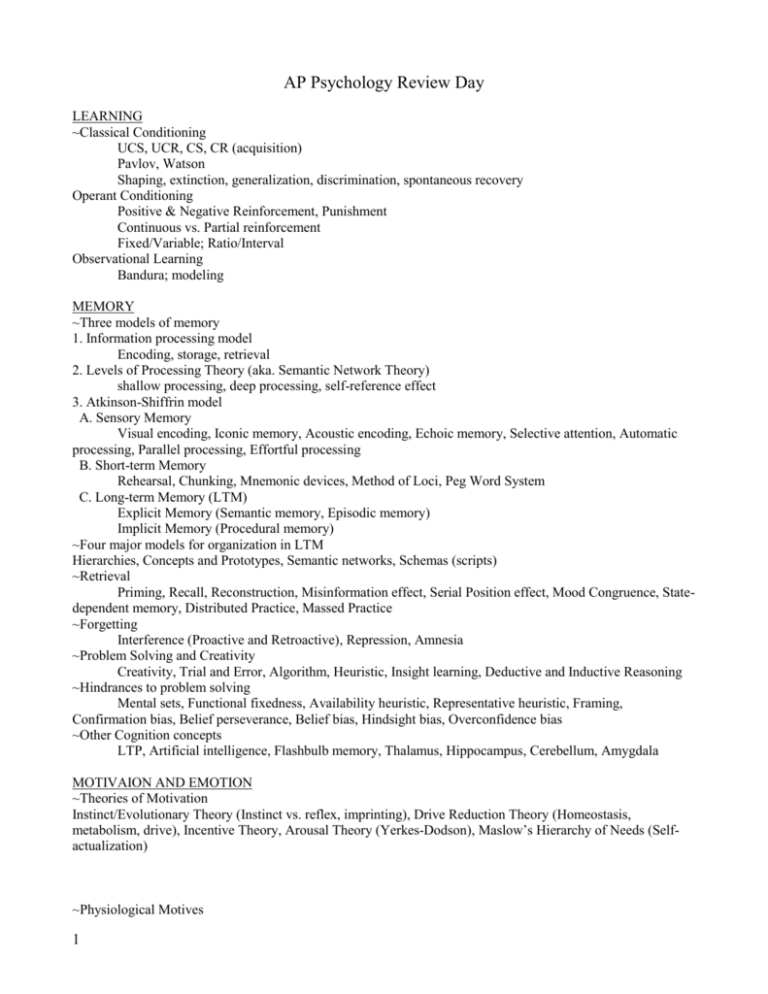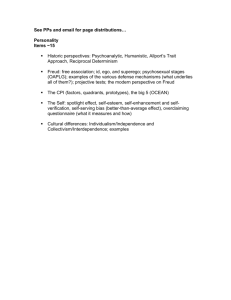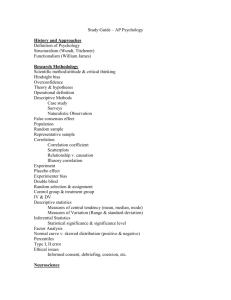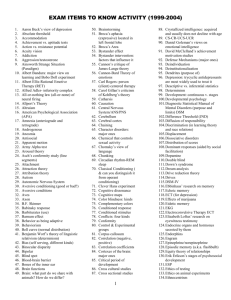AP Psychology Review
advertisement

AP Psychology Review Day LEARNING ~Classical Conditioning UCS, UCR, CS, CR (acquisition) Pavlov, Watson Shaping, extinction, generalization, discrimination, spontaneous recovery Operant Conditioning Positive & Negative Reinforcement, Punishment Continuous vs. Partial reinforcement Fixed/Variable; Ratio/Interval Observational Learning Bandura; modeling MEMORY ~Three models of memory 1. Information processing model Encoding, storage, retrieval 2. Levels of Processing Theory (aka. Semantic Network Theory) shallow processing, deep processing, self-reference effect 3. Atkinson-Shiffrin model A. Sensory Memory Visual encoding, Iconic memory, Acoustic encoding, Echoic memory, Selective attention, Automatic processing, Parallel processing, Effortful processing B. Short-term Memory Rehearsal, Chunking, Mnemonic devices, Method of Loci, Peg Word System C. Long-term Memory (LTM) Explicit Memory (Semantic memory, Episodic memory) Implicit Memory (Procedural memory) ~Four major models for organization in LTM Hierarchies, Concepts and Prototypes, Semantic networks, Schemas (scripts) ~Retrieval Priming, Recall, Reconstruction, Misinformation effect, Serial Position effect, Mood Congruence, Statedependent memory, Distributed Practice, Massed Practice ~Forgetting Interference (Proactive and Retroactive), Repression, Amnesia ~Problem Solving and Creativity Creativity, Trial and Error, Algorithm, Heuristic, Insight learning, Deductive and Inductive Reasoning ~Hindrances to problem solving Mental sets, Functional fixedness, Availability heuristic, Representative heuristic, Framing, Confirmation bias, Belief perseverance, Belief bias, Hindsight bias, Overconfidence bias ~Other Cognition concepts LTP, Artificial intelligence, Flashbulb memory, Thalamus, Hippocampus, Cerebellum, Amygdala MOTIVAION AND EMOTION ~Theories of Motivation Instinct/Evolutionary Theory (Instinct vs. reflex, imprinting), Drive Reduction Theory (Homeostasis, metabolism, drive), Incentive Theory, Arousal Theory (Yerkes-Dodson), Maslow’s Hierarchy of Needs (Selfactualization) ~Physiological Motives 1 Hunger (Lateral and ventromedial hypothalamus, insulin, glucose, leptin, cultural factors, metabolism, set point, obesity, anorexia, bulimia), Thirst (Similar hypothalamus regulation), Pain (Promotes avoidance or escape behaviors), Sexual (Hormones involved in puberty, societal regulation, sexual orientation, sexual response cycle, evolutionary view) ~Social Motivation Achievement (Thematic Apperception Test), Affiliation (Interaction of biological and social factors), Intrinsic vs. Extrinsic (Overjustification effect), Social Conflict Situations (Approach-approach, approach-avoidance, avoidance-avoidance, multiple conflicts) ~Theories of Emotion James-Lange, Cannon-Bard, Schachter Two Factor, Opponent Process, Cognitive Appraisal PERSONALITY ~Biological approach Temperament, Heritability, Evolutionary ~Psychoanalytic approach 3 levels of the mind, 3 major personality systems, Defense mechanisms, Stages of Development, Jung’s collective unconscious, Adler’s inferiority complexes, Horney attacked Freud’s male bias ~Humanistic approach Maslow, Rogers ~Behavioral approach Skinner ~Social-learning approach George Kelly, Bandura, Self-efficacy, Collective efficacy, Julian Rotter, Walter Mischel ~Trait Theory Gordon Allport, Hans Eysneck, Raymond Cattell ~Assessment techniques ABNORMAL PSYCH Causes of abnormal behavior by psychological perspective Societal stigmas of mental disorders Anxiety disorders (symptoms) Somatic disorders (symptoms) Dissociative disorders (symptoms, Freud’s explanation) Mood disorders (symptoms) Schizophrenia (symptoms: psychosis, delusions, and hallucinations) Personality disorders (general characteristics) Developmental disorders (general characteristics, symptoms) TREATMENT Psychoanalytic Behavioral Humanistic Cognitive Biological o Drugs: anti-anxiety, anti-depressants, anti-psychotics, stimulants SOCIAL Group Dynamics 2 Social group Norms Roles Social loafing Deindividuation Social facilitation Attributions Social cognition Attribution theory Dispositional factors Situational factors Interpersonal Perception Stereotypes Prejudice Discrimination Scapegoat theory Ethnocentrism Conformity, Compliance, and Obedience Conformity Compliance Attitudes and Change Attitudes Mere exposure effect Central route Peripheral route LANGUAGE 3 Phonemes Morphemes Grammar Syntax Semantics Babbling stage Telegraphic speech Linguistic relativity hypothesis Group polarization Groupthink Bystander intervention Diffusion of responsibility Altruism Fundamental attribution error Self-serving bias Self-fulfilling prophecy Actor-observer bias Just-world phenomenon Out-group homogeneity Contact theory Jigsaw classroom Foot-in-the door Reciprocity Informational social influence Normative social influence Aggression (instrumental, hostile)










